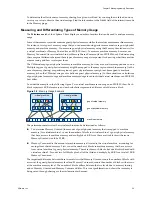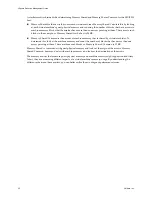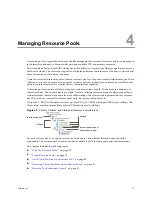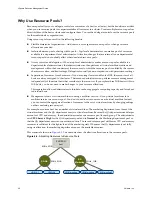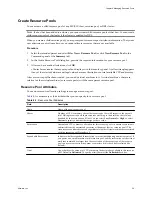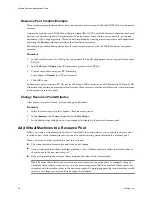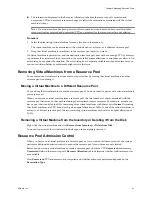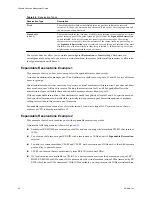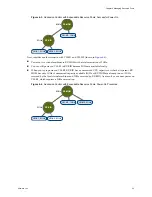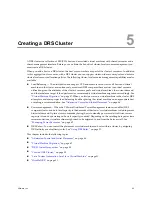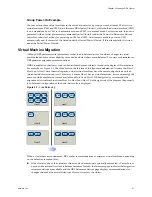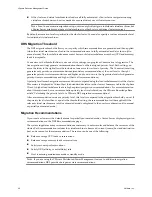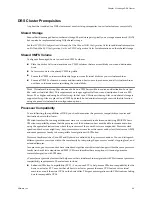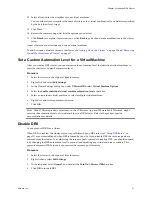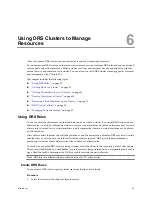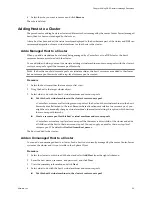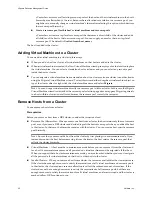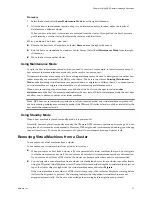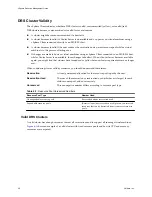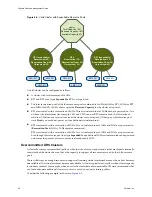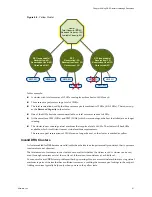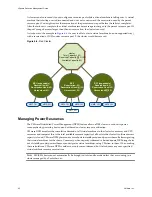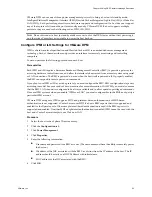
DRS Cluster Prerequisites
Any host that is added to a DRS cluster must meet certain prerequisites to use cluster features successfully.
Shared Storage
Ensure that the managed hosts use shared storage. Shared storage is typically on a storage area network (SAN)
but can also be implemented using NAS shared storage.
See the iSCSI SAN Configuration Guide and the Fibre Channel SAN Configuration Guide for additional information
on SAN and the ESX Configuration Guide or ESXi Configuration Guide for information on other shared storage.
Shared VMFS Volume
Configure all managed hosts to use shared VMFS volumes.
n
Place the disks of all virtual machines on VMFS volumes that are accessible by source and destination
hosts.
n
Set access mode for the shared VMFS to public.
n
Ensure the VMFS volume is sufficiently large to store all virtual disks for your virtual machines.
n
Ensure all VMFS volumes on source and destination hosts use volume names, and all virtual machines
use those volume names for specifying the virtual disks.
N
OTE
Virtual machine swap files also need to be on a VMFS accessible to source and destination hosts (just
like
.vmdk
virtual disk files). This requirement no longer applies if all source and destination hosts are ESX
Server 3.5 or higher and using host-local swap. In that case, VMotion with swap files on unshared storage is
supported. Swap files are placed on a VMFS by default, but administrators might override the file location
using advanced virtual machine configuration options.
Processor Compatibility
To avoid limiting the capabilities of DRS, you should maximize the processor compatibility of source and
destination hosts in the cluster.
VMotion transfers the running architectural state of a virtual machine between underlying ESX/ESXi hosts.
VMotion compatibility means that the processors of the destination host must be able to resume execution
using the equivalent instructions where the processors of the source host were suspended. Processor clock
speeds and cache sizes might vary, but processors must come from the same vendor class (Intel versus AMD)
and same processor family to be compatible for migration with VMotion.
Processor families such as Xeon MP and Opteron are defined by the processor vendors. You can distinguish
different processor versions within the same family by comparing the processors’ model, stepping level, and
extended features.
In some cases, processor vendors have introduced significant architectural changes within the same processor
family (such as 64-bit extensions and SSE3). VMware identifies these exceptions if it cannot guarantee
successful migration with VMotion.
vCenter Server provides features that help ensure that virtual machines migrated with VMotion meet processor
compatibility requirements. These features include:
n
Enhanced VMotion Compatibility (EVC) – You can use EVC to help ensure VMotion compatibility for the
hosts in a cluster. EVC ensures that all hosts in a cluster present the same CPU feature set to virtual
machines, even if the actual CPUs on the hosts differ. This prevents migrations with VMotion from failing
due to incompatible CPUs.
Chapter 5 Creating a DRS Cluster
VMware, Inc.
49
Summary of Contents for ESX 4.0
Page 6: ...vSphere Resource Management Guide 6 VMware Inc...
Page 44: ...vSphere Resource Management Guide 44 VMware Inc...
Page 52: ...vSphere Resource Management Guide 52 VMware Inc...
Page 72: ...vSphere Resource Management Guide 72 VMware Inc...
Page 80: ...vSphere Resource Management Guide 80 VMware Inc...

